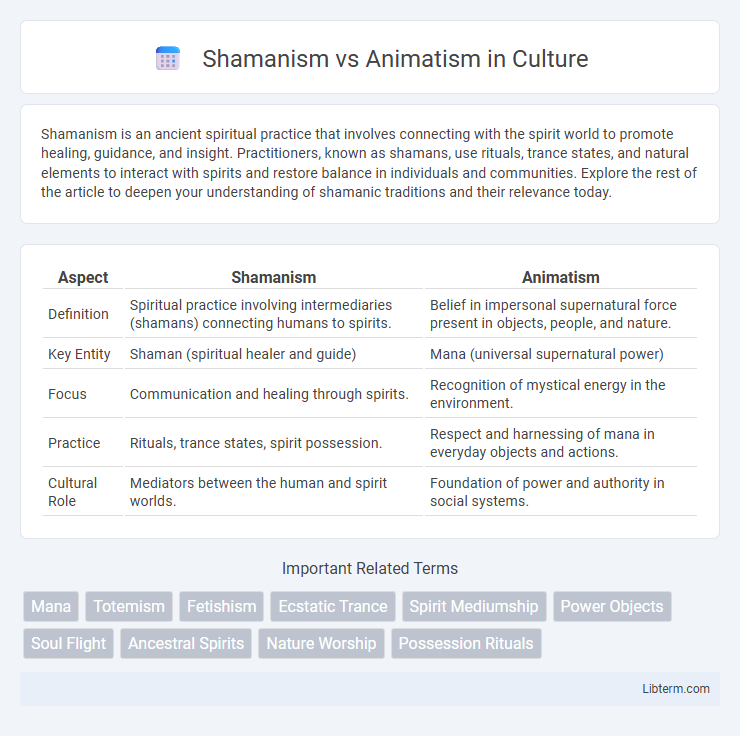Shamanism is an ancient spiritual practice that involves connecting with the spirit world to promote healing, guidance, and insight. Practitioners, known as shamans, use rituals, trance states, and natural elements to interact with spirits and restore balance in individuals and communities. Explore the rest of the article to deepen your understanding of shamanic traditions and their relevance today.
Table of Comparison
| Aspect | Shamanism | Animatism |
|---|---|---|
| Definition | Spiritual practice involving intermediaries (shamans) connecting humans to spirits. | Belief in impersonal supernatural force present in objects, people, and nature. |
| Key Entity | Shaman (spiritual healer and guide) | Mana (universal supernatural power) |
| Focus | Communication and healing through spirits. | Recognition of mystical energy in the environment. |
| Practice | Rituals, trance states, spirit possession. | Respect and harnessing of mana in everyday objects and actions. |
| Cultural Role | Mediators between the human and spirit worlds. | Foundation of power and authority in social systems. |
Defining Shamanism: Core Beliefs and Practices
Shamanism centers on the belief in spirits that inhabit natural and supernatural realms, with shamans acting as intermediaries to communicate, heal, and guide through trance states and ritual practices. Core practices include soul journeying, spirit possession, and the use of symbolic tools like drums and masks to access altered states of consciousness. Unlike animatism, which attributes a generalized spiritual force to objects and places, shamanism involves active interaction with distinct spiritual beings and complex shamanic knowledge systems.
Understanding Animatism: Key Concepts and Origins
Animatism represents a core concept in anthropology, describing the belief in a generalized, impersonal supernatural force that pervades objects and beings, unlike Shamanism which centers on spiritual practitioners interacting with specific spirits. Originating from early human societies, Animatism is foundational in understanding how ancient cultures explained natural phenomena through an abstract spiritual power rather than personalized deities. This belief system highlights the idea that supernatural energy or mana exists in everything, influencing human behavior and society's relationship with the environment.
Historical Roots: Shamanism and Animatism Through Time
Shamanism traces its historical roots to Siberian and Central Asian indigenous cultures, where shamans acted as intermediaries between the spiritual and physical worlds through trance and ritual. Animatism, a concept introduced in early anthropological studies by Robert Marett, reflects a belief in impersonal supernatural forces and predates organized religion in many ancient societies worldwide. Both systems represent foundational spiritual frameworks that influenced social structures and cosmologies in prehistoric and early historic human communities.
Cosmology: Spiritual Entities vs. Impersonal Forces
Shamanism centers on cosmology that involves interactions with spiritual entities such as spirits, ancestors, and deities, believed to influence the natural and supernatural realms. In contrast, Animatism posits an impersonal force or power permeating objects and beings, lacking distinct personalities but capable of affecting outcomes. This fundamental difference shapes ritual practices, where shamans negotiate with conscious spirits, while animatistic cultures harness and manipulate diffuse, nameless powers.
Rituals and Ceremonies: Practitioners and Methods
Shamanism rituals involve shamans entering trance states to communicate with spirits using drumming, chanting, and dancing for healing or guidance, often performed individually or in small groups. Animatism ceremonies center on harnessing impersonal spiritual forces through offerings, taboos, and communal rites aimed at influencing luck or natural events, typically conducted by community leaders or elders. Both systems utilize ritualistic tools and symbolic acts but differ in practitioners' roles, with shamans acting as intermediaries and animatism relying on collective ceremonies to manage spiritual power.
The Role of the Shaman vs. Community Participation
The shaman acts as a spiritual intermediary, using trance and ritual to communicate with spirits, healing, and guiding the community in shamanism. In animatism, spiritual power is viewed as a diffuse, impersonal force present in objects and beings, with community members collectively engaging in rituals to harness this power. The role of the shaman is specialized and individual, contrasting with animatism's emphasis on shared community participation in spiritual practices.
Supernatural Power: Personal Spirits vs. Universal Life Force
Shamanism centers on engaging personal spirits, where shamans act as intermediaries to harness and communicate with individual supernatural entities for healing and guidance. In contrast, animatism emphasizes a universal life force, a diffuse and impersonal supernatural power present throughout nature and objects, rather than distinct spirit beings. This fundamental difference highlights shamanism's reliance on spirit interaction versus animatism's belief in an omnipresent, animating energy.
Cultural Influence: Shamanism and Animatism Worldwide
Shamanism and Animatism both profoundly shape cultural beliefs and practices worldwide, with shamanism emphasizing spiritual intermediaries and animatism focusing on inherent sacred forces in objects or beings. Shamanistic traditions thrive in regions such as Siberia, Mongolia, and indigenous communities in the Americas, reinforcing rituals and healing practices deeply embedded in their cultural identity. Animatism influences diverse societies by attributing spiritual power to natural elements, fostering respect for nature and guiding social conduct in cultures across Africa, Oceania, and Southeast Asia.
Modern Interpretations and Revival Movements
Modern interpretations of shamanism emphasize its role in personal spiritual healing, ecological awareness, and intercultural connection, often integrating psychology and indigenous practices. Revival movements blend traditional animatist beliefs of impersonal spiritual forces with contemporary holistic healing and new age spirituality, reflecting a growing interest in non-Western cosmologies. Both frameworks contribute to the resurgence of indigenous knowledge systems and the personalization of spiritual experiences in the 21st century.
Comparative Analysis: Differences and Similarities
Shamanism centers on individuals known as shamans who mediate between the human and spirit worlds through rituals, healing practices, and trance states, whereas animatism emphasizes a pervasive impersonal force or power believed to inhabit objects, places, and beings. Both belief systems recognize spiritual influences on the natural world and human life, but shamanism involves specific practitioners exerting control over spirits, while animatism attributes power more diffusely without personalized agents. The distinction lies in shamanism's ritualistic mediation and animatism's generalized spiritual embodiment, reflecting diverse ways cultures understand and interact with the supernatural.
Shamanism Infographic

 libterm.com
libterm.com